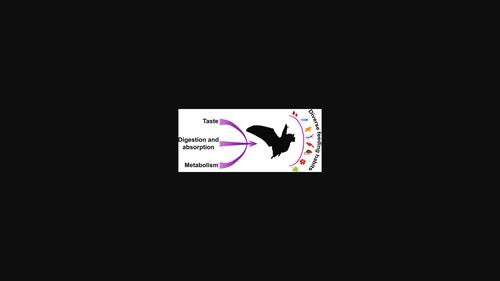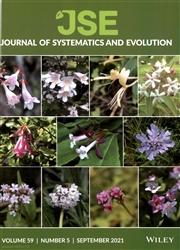新世界叶鼻蝠(Phyllostomidae)食性多样化的基因组和功能洞察
IF 2.9
1区 生物学
Q1 Agricultural and Biological Sciences
引用次数: 0
摘要
新大陆叶鼻蝠(Phyllostomidae)适应性辐射的最重要驱动因素是它们显著多样的觅食习性,但针对该科觅食多样化的遗传基础的研究仍然明显不足。在这项研究中,我们为叶蝠科的一个代表性物种--流苏唇蝠(Trachops cirrhosis)组装了一个新的基因组,并将其与已发表的 8 个叶蝠基因组以及另外 10 个其他蝙蝠物种的基因组进行了整合。通过对10 200个同源基因进行比较基因组分析,我们发现,在蝙蝠科中受到差异选择的基因明显富集于新陈代谢相关的途径中。此外,我们还在苦味受体基因Tas2r1以及参与消化碳水化合物、蛋白质和脂肪等关键营养物质的14个基因中发现了分化选择的分子特征。此外,我们对 Tas2r1 进行的基于细胞的功能测试显示,与非叶蝠类相比,叶蝠类对苦味化合物的感知范围更广,这表明叶蝠类的苦味功能多样化。通过基因组和功能分析,我们认为与味觉、消化吸收和新陈代谢相关的基因的分化选择在引导叶口蝠科极端饮食多样化的过程中发挥了关键作用。这项研究不仅揭示了叶蝠科蝙蝠饮食适应性的遗传机制,而且加深了我们对其非凡的适应性辐射的理解。本文章由计算机程序翻译,如有差异,请以英文原文为准。

Genomic and functional insights into dietary diversification in New World leaf‐nosed bats (Phyllostomidae)
The most significant driver of adaptive radiation in the New World leaf‐nosed bats (Phyllostomidae) is their remarkably diverse feeding habits, yet there remains a notable scarcity of studies addressing the genetic underpinnings of dietary diversification in this family. In this study, we have assembled a new genome for a representative species of phyllostomid bat, the fringe‐lipped bat (Trachops cirrhosis ), and integrated it with eight published phyllostomid genomes, along with an additional 10 genomes of other bat species. Comparative genomic analysis across 10 200 orthologus genes has unveiled that those genes subject to divergent selection within the Phyllostomidae clade are notably enriched in metabolism‐related pathways. Furthermore, we identified molecular signatures of divergent selection in the bitter receptor gene Tas2r1 , as well as 14 genes involved in digesting key nutrients such as carbohydrates, proteins, and fats. In addition, our cell‐based functional assays conducted on Tas2r1 showed a broader spectrum of perception for bitter compounds in phyllostomids compared to nonphyllostomid bats, suggesting functional diversification of bitter taste in Phyllostomidae. Together, our genomic and functional analyses lead us to propose that divergent selection of genes associated with taste, digestion and absorption, and metabolism assumes a pivotal role in steering the extreme dietary diversification in Phyllostomidae. This study not only illuminates the genetic mechanisms underlying dietary adaptations in Phyllostomidae bats but also enhances our understanding of their extraordinary adaptive radiation.
求助全文
通过发布文献求助,成功后即可免费获取论文全文。
去求助
来源期刊

Journal of Systematics and Evolution
Agricultural and Biological Sciences-Ecology, Evolution, Behavior and Systematics
CiteScore
7.40
自引率
8.10%
发文量
1368
审稿时长
6-12 weeks
期刊介绍:
Journal of Systematics and Evolution (JSE, since 2008; formerly Acta Phytotaxonomica Sinica) is a plant-based international journal newly dedicated to the description and understanding of the biological diversity. It covers: description of new taxa, monographic revision, phylogenetics, molecular evolution and genome evolution, evolutionary developmental biology, evolutionary ecology, population biology, conservation biology, biogeography, paleobiology, evolutionary theories, and related subjects.
 求助内容:
求助内容: 应助结果提醒方式:
应助结果提醒方式:


